Are you a gym owner struggling to choose the right flooring for your facility? Deciding on the flooring should be your top priority to improve its overall appearance.
As an gym facility manager, I’ve guided numerous gym owners through key decisions in selecting the best flooring to suit their needs.
Selecting the perfect gym flooring isn’t just about aesthetics, it’s about safety and efficiency. Choosing the right one helps reduces maintenance, prevents injuries, and improves your gym’s overall appeal.
In this guide, we’ll break down the best gym flooring materials, recommended thickness for different areas, and why these choices matter for your gym.
So let’s get started!
Table of Contents
1. Quick Comparison Chart
When choosing gym flooring, there are many options to think about. Each type has different features that you should consider before making a choice. To guide you, the table below compares these features for the most common flooring materials:
Flooring Material | Price | Durability | Ease of Installation | Shock Absorption | Ease of Cleaning |
Rubber Tiles | Mid-range | Extremely durable and long-lasting | Very easy to install; tiles fit together like puzzle pieces | Excellent shock absorption, ideal for high-impact activities | Easy to clean; typically requires basic sweeping or mopping |
Rubber Rolls | Low | Very durable, especially in high-traffic areas | Easy to install; requires cutting and rolling out | High shock absorption, good for general gym use | Easy to clean with sweeping or mopping |
Rubber Mats | Mid-range | Highly durable, resistant to wear and tear | Very easy to place, often just lay down where needed | Excellent shock absorption, good for weightlifting areas | Simple cleaning with basic sweeping |
Turf | High | Moderate durability, may wear over time in high-traffic areas | Difficult to install, usually requires professional help | Low shock absorption, better for agility training or sprints | Requires frequent maintenance, such as vacuuming or brushing |
EVA Tiles | Very low | Medium durability, can dent or compress under heavy weight | Extremely easy to install, tiles fit together easily | High shock absorption, good for low-impact exercises | Very easy to clean, typically just needs mopping |
Carpet Tiles | Very low | Medium durability, wears down in high-traffic areas | Moderate difficulty, requires proper alignment and adhesive | Low shock absorption, not ideal for heavy impact | Moderate cleaning effort; vacuuming needed regularly |
PVC/Vinyl | Very high | Extremely tough and resistant to wear and tear | Easy to install, can be rolled out or laid down easily | Minimal shock absorption, better for general exercise use | Easy to clean, requires only basic sweeping and mopping |
Wood | Very high | Medium durability, prone to scratches and dents | Average installation difficulty; may need professional assistance | Low shock absorption, more suitable for aesthetic and light gym activities | Moderate cleaning required; regular sweeping and polishing |
2. Gym Flooring Types by Material
There are many flooring options available today, making it hard to pick the right one for your gym. In this section, we’ll go over some popular materials used in fitness centers. Here are some of them:
Rubber Flooring
Rubber is one of the most common materials for gym floors. It’s popular because it’s versatile and works well for many types of workouts. Another big benefit is its ability to absorb shock, which protects the floor underneath from damage. It comes in different forms, and listed below are some of it.

Rubber Rolls
Rubber rolls are great if you want a seamless look for your gym. They have fewer joints, and the edges fit well, so you don’t have to worry about gaps forming over time. Rubber rolls are also good for high-impact exercises, like plyometrics, since they help cushion the joints and provide a comfortable workout surface. At YR Fitness, we offer a wide selection of gym equipment that’s perfectly suited for use with rubber roll flooring.
Pros:
- Durable: Rubber roll flooring lasts for many years and sometimes over a decade so it don’t need to replace it anytime soon.
- Easy to Clean: Since it’s waterproof, rubber doesn’t let water seep in and prevents mold or mildew from growing. A quick vacuum or mop will keep it clean.
- Shock Absorbing: This type of flooring cushions the body during intense exercises and heavy lifting, protecting joints.
- Germ-Resistant: The material is antibacterial, which helps keep germs and other growths away.
- Reducing Noise: Rubber absorbs sound, so people can work out without making too much noise.
Cons:
- Hard to Install: Rubber rolls are heavy, so it might need a few people to help with the installation.
- Poor Insulator: Rubber rolls don’t hold in heat, so the floor can feel cold if the ground underneath is cold. It needs a heating system for the flooring.
- Rubbery Smell: Sometimes, rubber rolls give off a strong smell, which can bother people who are sensitive to it.
- Sensitive to Sunlight: UV rays can cause the color of rubber flooring to fade, so it should be protected from direct sunlight.
- Latex Allergy Risk: Some people with latex allergies may react to rubber flooring.

Rubber Tiles
Rubber tiles are another popular choice for commercial gyms. They are long-lasting and affordable. These tiles are shaped like large puzzle pieces, making them easy to install by fitting them together in a pattern.
Pros:
- Easy to Install: Installing rubber tiles is simple, as they fit together like pieces of a jigsaw puzzle, making the process enjoyable for some.
- Lighter Weight: Rubber tiles are lighter than rubber rolls, making them easier to handle and move during installation.
Cons:
- Time-Consuming: Although installation is easy, it can be time-consuming when covering large areas, making rubber tiles more suitable for smaller spaces.
- More Seams: While rubber tiles appear mostly seamless, they don’t offer the same smooth finish as rubber rolls.
- Rubbery Smell: Similar to other rubber flooring, rubber tiles can emit a strong odor.
- Allergy Risk: Individuals with latex allergies may experience reactions with rubber tiles.
- More Expensive: Rubber tiles are generally pricier compared to rubber rolls.
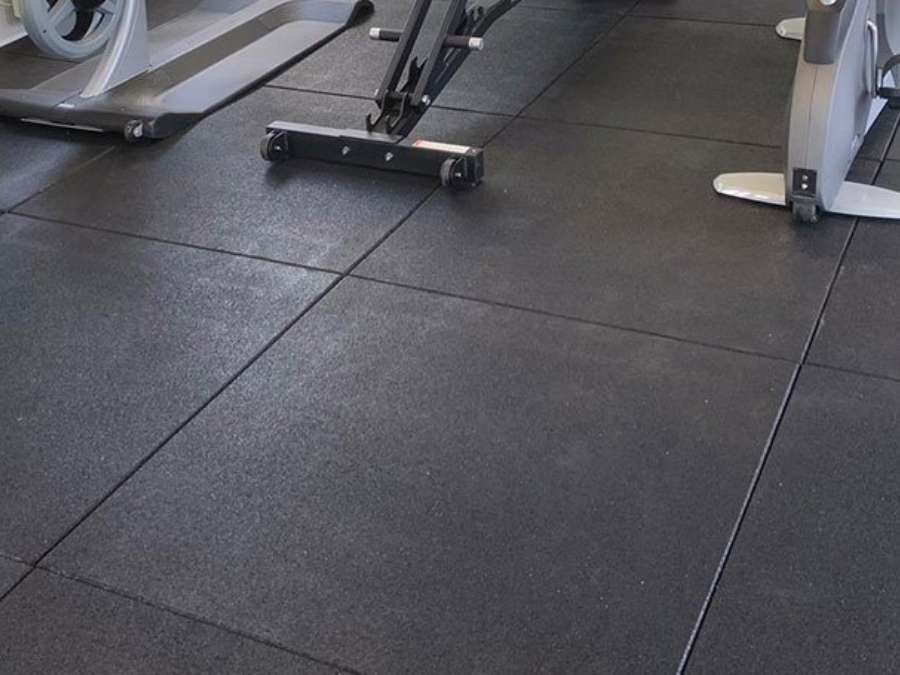
Rubber Mats
Rubber mats are ideal for small spaces or areas where heavy lifting takes place. Extra-thick mats are great for weightlifting zones and can be placed in specific areas of your gym to handle intense exercises.
Pros:
- Very durable: These mats are designed to handle heavy weights and tough workouts.
- Perfect for Small Spaces: Rubber mats are a budget-friendly option if you’re covering small areas and are short on time.
- No Installation Needed: You can simply place rubber mats on the floor—no need for complicated setup.
- Reduces Noise: Rubber mats help keep noise inside the gym, so heavy equipment doesn’t disturb anyone nearby.
- Shock Absorbing: They protect both your members’ joints and the floor beneath from damage during intense workouts.
- Waterproof and Antibacterial: These mats prevent water buildup and keep your gym clean from mold and bacteria.
- Easy to Move: You can easily pick up and move rubber mats whenever needed.
Cons:
- Not for Large Spaces: Rubber mats aren’t the best option for large areas, rubber rolls are more efficient and cost-effective.
- Allergy Risk: People with latex allergies may have reactions to rubber flooring.
- Rubbery Smell: Like other rubber flooring, mats can have a strong odor.
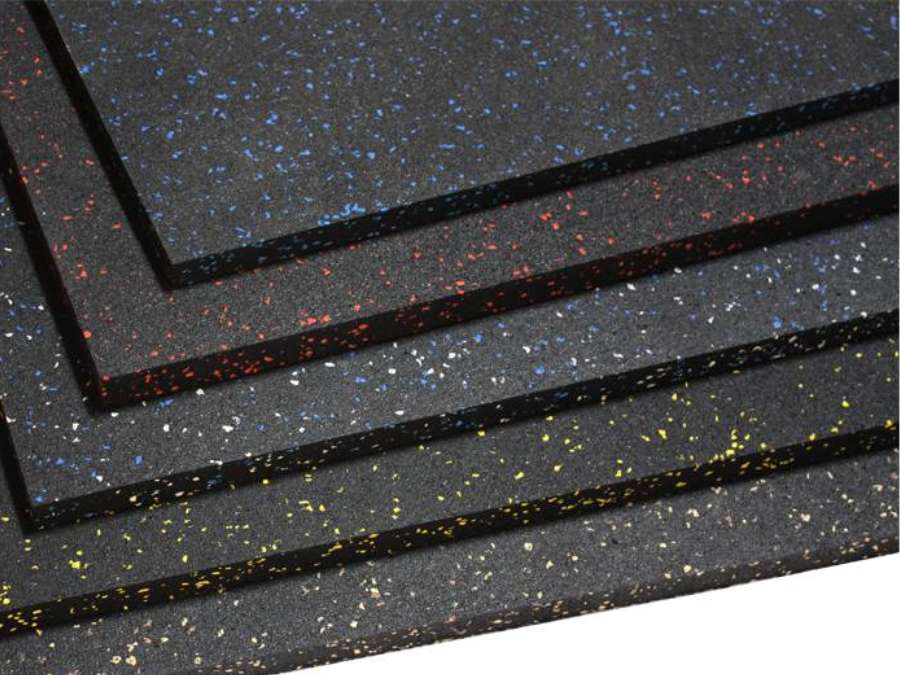
Turf Flooring
Many commercial gyms choose indoor turf for its safety and durability. Turf is ideal for fast-paced workouts due to its shock-absorbing properties, which help protect joints and lower the risk of injury. A smaller strip of turf, typically 3 to 5 meters wide, can also be installed for specific exercises, while other flooring options are used throughout the rest of the gym. Below are the different types of turf flooring:
Turf Rolls
Turf rolls are a great long-lasting flooring option for gyms. They handle high-intensity workouts like functional training and sled pushes. Turf also helps reduce noise, making it ideal for gyms with heavy weights and intense exercises. The soft, synthetic grass provides a cushioned surface, perfect for stretching and yoga too.
Pros:
- Durable: Turf is tough and stays looking good for a long time, even with heavy use.
- Low-Maintenance: It’s easy to care for and doesn’t need a lot of upkeep.
- Works for Many Workouts: Turf can handle running, gymnastics, and tough workouts like Functional Training.
- Shock Absorbing: The padded grass protects joints by reducing the impact of exercises.
- Aesthetic: Sports turf flooring with artificial grass adds a sleek, modern look to any gym.
Cons:
- Hard to Clean: Turf can collect bacteria like Staph and MRSA if not cleaned properly, which poses health risks.
- Uncomfortable for Floor Exercises: Its rough texture can feel uncomfortable during floor exercises like burpees.
- Not Great for Protecting the Floor: If heavy weights will be dropped, an additional protective layer is needed to safeguard the floor underneath. Some brands offer turf with a built-in protective layer.
- Expensive: Synthetic turf can be costly, although more affordable options are available.

Turf Tiles
Turf tiles are very similar to turf rolls. The main differences are how they’re installed, the type of floor, and their cost. For floors with tricky shapes, turf tiles are a better option than rolls. Rolls work well for straight gym lanes, while tiles are ideal for spaces with odd shapes. However, turf tiles tend to be more expensive than other gym flooring options, including turf rolls.
Pros:
- Good for odd-shaped floors: It can be easily cut to fit non-rectangular spaces.
- Interlocking design: Turf tiles fit together like puzzle pieces, similar to rubber tiles.
Cons:
- Expensive: Turf tiles are one of the more costly options for gym flooring.
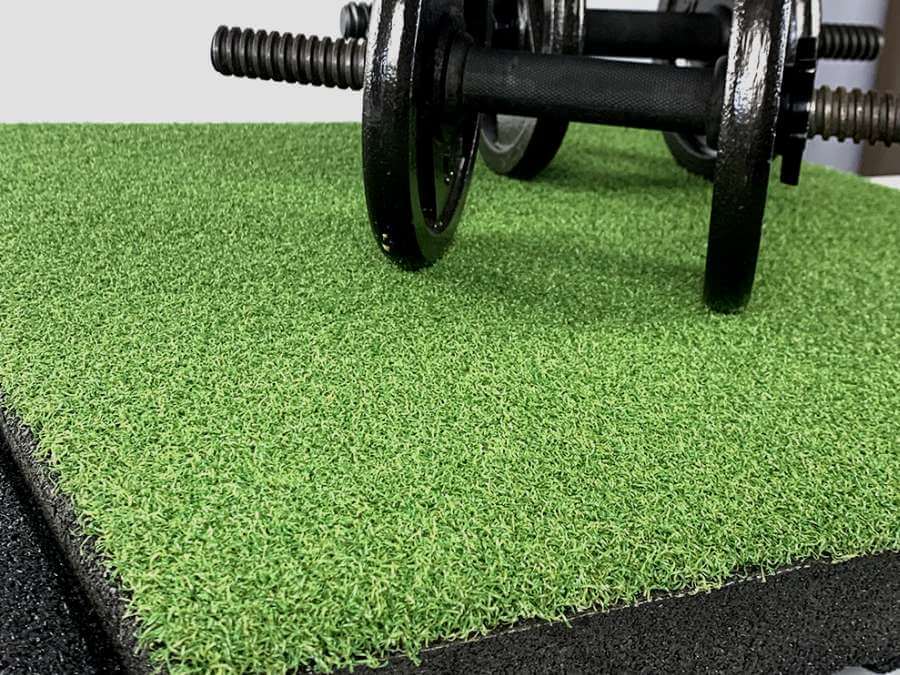
EVA Flooring
EVA tiles are a budget-friendly alternative to rubber, offering good versatility and durability. There are 2 types of EVA tiles: open cell foam and closed cell foam. Closed cell EVA tiles are recommended for their superior durability and faster recovery when stepped on. In contrast, open cell foam tiles tend to sink under heavy steps or movements.
Pros:
- Low Cost: Foam is the most affordable gym flooring option available.
- Easy Installation: Simply lay out the tiles and lock them together.
- Great for Floor Exercises: The cushioned surface is perfect for exercises like stretching and sit-ups.
- Easy to Clean: A damp cloth is all what needed to wipe them down.
- Lightweight: Foam tiles are easy to move around thanks to their light weight.
- Kid-Friendly: Foam tiles are often used in play areas because they absorb shocks and prevent injuries.
- Aesthetic Variety: Different colors can mix to create a unique flooring design tailored to your style.
Cons:
- Easily Damaged by Sharp Objects: Foam can be punctured or cut by things like high heels, which should be kept out of the gym.
- Prone to Denting: Gym machines and equipment can leave dents in the foam flooring.

Carpet Flooring
Carpet flooring gives fitness centers a warm, inviting feel. It’s great for workouts like stretching and yoga, especially when using mats. Commercial-grade carpet tiles are much tougher than regular home carpets, designed to handle the impact of exercise. Some brands even offer interlocking, waterproof tiles.
Pros:
- Durable: Carpet tiles are long-lasting and can handle years of wear and tear before needing replacement.
- Easy Maintenance: Cleaning and maintaining carpet tiles is similar to caring for home carpets, making it simple for most people.
- Warm and Inviting: Carpet flooring feels cozy and works well for a variety of workouts.
- Color Variety: You can pick from a wide range of colors to match your gym’s style.
Cons:
- Allergen Buildup: Carpet can collect dust, allergens, and microorganisms, which can worsen asthma or allergies.
- Professional Installation Needed: Non-interlocking carpet tiles often require professional installation, which can add to costs.
- Poor Subfloor Protection: Unlike rubber, carpet doesn’t protect the floor underneath from heavy weights or impact. A protective layer may be needed.
- Re-stretching Over Time: Carpet can stretch out from heavy use and may need professional re-stretching to keep it smooth.
- Hard to Clean: Traditional carpet tiles can absorb sweat and moisture, leading to odors, mold, or mildew. Regular professional cleaning is needed to manage this.
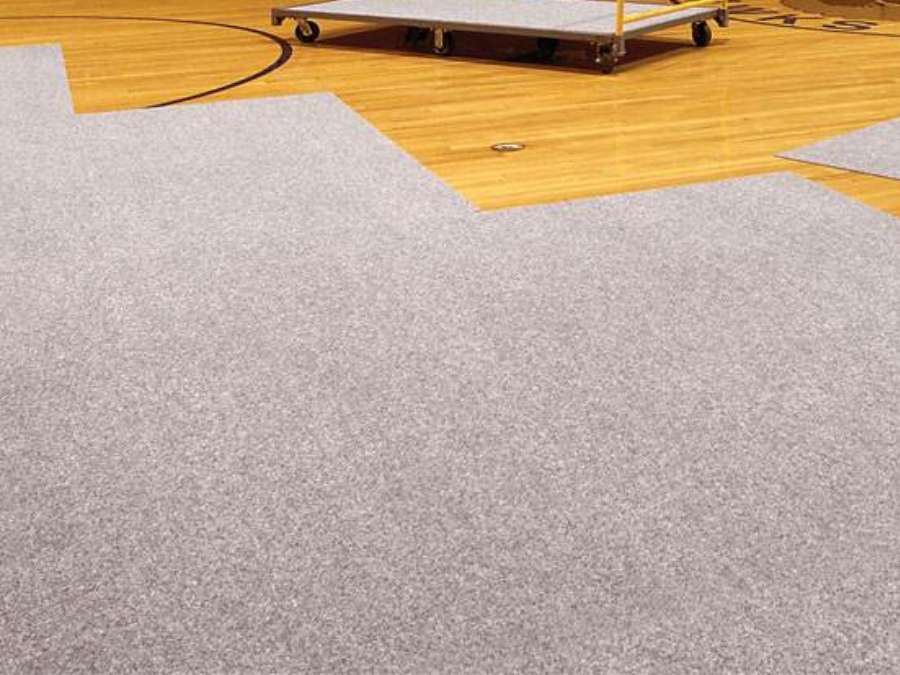
PVC (Vinyl) Flooring
For gym owners looking for colorful flooring, PVC or vinyl can be a great option. Originally designed for garage floors, PVC is tough enough to handle the heavy impact and loading in gyms. It’s durable, comes in tiles or rolls, and can be installed by yourself. Vinyl flooring also offers creative, fun designs.
Pros:
- Durable: This flooring can handle heavy impacts and resist damage from chemicals, stains, and oil. Many brands also provide warranties.
- Easy to Clean: A simple solution of soap and water is all you need to keep it clean.
- DIY Installation: Vinyl tiles and rolls are easy to install on your own.
- Wide Color Choices: You can customize your vinyl flooring with fun patterns like checkered designs or other creative layouts.
Cons:
- Prone to Damage: Sharp or heavy objects can easily tear or puncture vinyl flooring.
- Less Shock Absorption: Unlike rubber or foam, vinyl doesn’t cushion joints during high-impact exercises.
- VOC Release: Vinyl can release volatile organic compounds (VOCs), which may have potential health risks.
- Expensive: Vinyl flooring tends to be more expensive than other gym flooring options.
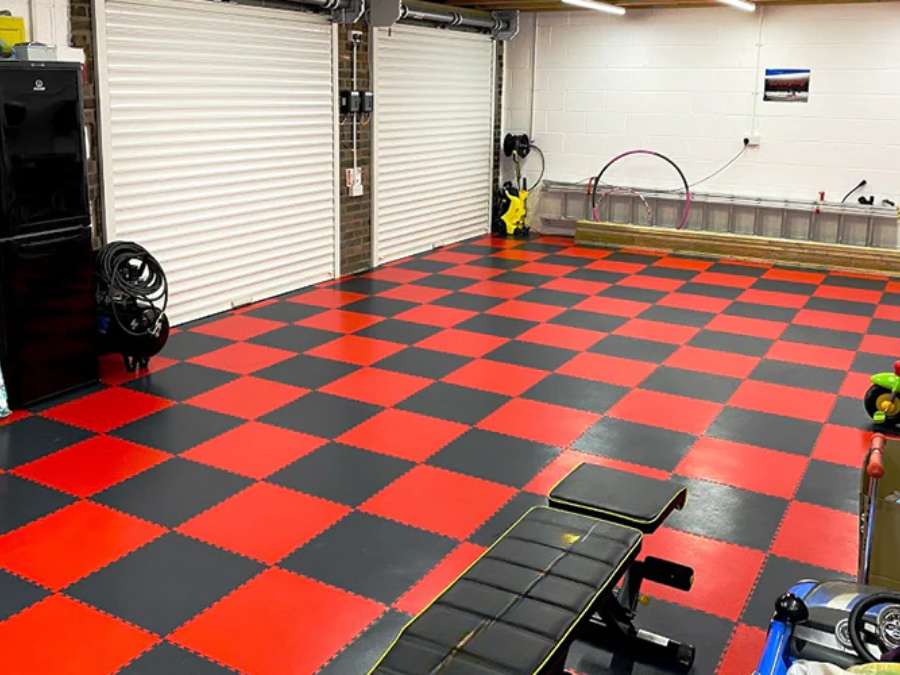
Wood Flooring
Wood flooring is a strong and durable choice for many fitness environments. It adds a classy appearance to any gym or studio and can withstand wear and tear. For those concerned about it being too hard for floor exercises or high-intensity workouts, foam-backed wood flooring is an option. This type offers shock absorption, reducing the risk of injuries while supporting a variety of exercises.
Pros:
- Durable and Versatile: Wood flooring works well for a wide range of activities, from aerobics to kickboxing, and looks great in any setting.
- Easy to Clean: A quick vacuum or mop will keep your wood flooring looking good.
Cons:
- Scratches and Splinters: Heavy impacts, like dropping weights, can cause splinters or scratches.
- Slippery when wet: Sweat or moisture can make wood floors slippery, increasing the risk of falls.
- Noisy: Wood flooring amplifies sound, which can make your gym louder.
- Higher Cost: Wood is one of the most expensive flooring options.
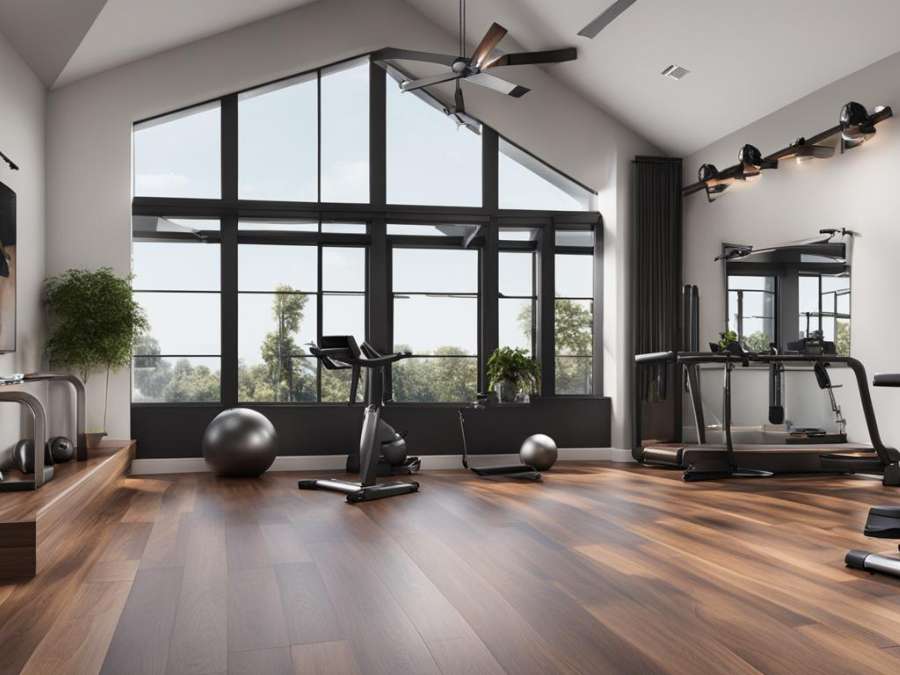
3. Gym Flooring Physical Properties
When choosing the right gym flooring, it’s essential to consider the physical properties that will impact performance, durability, and safety. Each material offers unique characteristics suited for specific types of workouts. Here are the key physical properties to consider when selecting gym flooring:
Thickness
The thickness of your gym flooring affects how well it protects the floor underneath. Wanna know why? If your flooring isn’t thick enough, heavyweights can damage the subfloor. Below are some lists of recommended thickness:
- 1/4 Inch: This is the thinnest option, best for cardio areas and spaces with exercise machines. It can handle light impacts, like small dumbbells dropping or people walking, and works well in hallways.
- 3/8 Inch: The most common thickness, suitable for weights up to 75 pounds. This used to be the standard in most gyms.
- 1/2 Inch: Ideal for high-intensity workouts like HIIT jumps or occasional impacts from weights around 100 pounds.
- 3/4 to 1 Inch: This is uncommon and usually not necessary unless heavy loads of around 100 lbs are repeatedly dropped for some reason.
Edge Alignment
Make sure that the edges and corners of your flooring align smoothly with the surrounding floor to prevent tripping and maintain safety in your gym. Here are some key considerations to ensure proper edge merging:
- Wall-to-Wall Coverage: Make sure the flooring reaches all the way to the walls. If there are exposed corners or gaps, adding extra tiles or custom-cut pieces can help cover those areas. This prevents any open spaces that could create hazards or look unfinished.
- Smooth Transitions: If you’re working with multiple types of flooring in different areas, make sure the transition between them is smooth. Using transition strips or reducers can help create a level change without the risk of tripping.
- Securing Loose Edges: For rolled flooring, make sure the edges are properly secured, either with adhesive or by using border pieces. Loose edges can curl over time, which can lead to a potential safety hazard.
Waterproof
It’s important for gym flooring to be waterproof and not absorb moisture. This is especially true if your gym has showers, pools, or a sauna, where there’s a higher chance of water damage. Waterproof flooring is easier to clean and maintain, and it helps prevent mold and mildew from forming. Here are some lists of waterproof flooring:
- Rubber Flooring: Durable and water-resistant, perfect for areas prone to moisture like weight rooms or areas near water fountains.
- PVC/Vinyl Flooring: Completely waterproof, ideal for locker rooms, saunas, and areas around pools.
- Foam Tiles: Water-resistant and easy to clean, suitable for areas where light moisture is expected, though not ideal for high-water zones.
- Sealed Concrete: Provides excellent water resistance and durability, often used in large gym areas or under heavy equipment, but can be slippery when wet if not treated with a non-slip finish.
Color
Choosing the color of gym flooring requires careful consideration. It should complement the overall décor of the space, but also suit the activities in each flooring zone and the level of cleaning needed. In fact, according to Maybray, color can increase brand awareness by 80%. Here’s some lists of colors you may consider:
- Black or Charcoal: Great for weightlifting zones; hides dirt and scuffs, easy to maintain.
- Gray: Neutral tone that works in most areas, balances brightness and dirt-hiding capabilities.
- Red or Orange: Ideal for high-energy spaces like cardio areas, boosts motivation and energy.
- Blue: Calming color, perfect for yoga or stretching areas, creates a relaxed atmosphere.
- Green: Suitable for turf or agility training zones, mimics outdoor environments.
- Beige or Light Gray: Brightens small or dark spaces but shows dirt more easily, needs more cleaning.
- Dark Green or Brown: Earthy tones that blend well with natural themes, good for gyms aiming for a grounded, calm feel.
Thermal Expansion and Contraction
This is a factor many people tend to ignore. Temperature-sensitive flooring materials can expand in hot weather and contract in cold conditions. To manage this, it’s best to install expansion joints with such flooring. Experts recommend placing the flooring in its designated area for 2 days before installation to allow it to acclimate.
4. Specialty Flooring for Different Gym Areas
Different gym areas need specific flooring to support the activities done in each space and choosing the right flooring can improve performance and safety. Here are some key flooring options for each gym section:
Weightlifting Areas
Weightlifting areas need strong flooring that can handle the impact of heavy weights. Rubber flooring is commonly used here because it absorbs shock, protects the ground, and reduces noise. And on top of that, thicker rubber tiles or rolls provide extra cushioning and help prevent damage when weights are dropped.
Cardio and Machine Areas
In cardio and machine areas, the flooring needs to support high foot traffic and the weight of machines. PVC or vinyl flooring is a great option as it’s durable and easy to clean. If you prioritize this area in your gym and are looking for additional cardio equipment, YR Fitness offers a wide range of cardio equipment including treadmills, bikes, and rowing machine, designed to enhance your gym’s performance and appeal.
Aerobic Areas
Aerobic areas require flooring that provides both comfort and flexibility for various movements. Foam-backed wood or rubber tiles are ideal choices as they offer good shock absorption and help prevent injuries during high-intensity workouts. These materials also provide enough grip for safe and smooth movement.
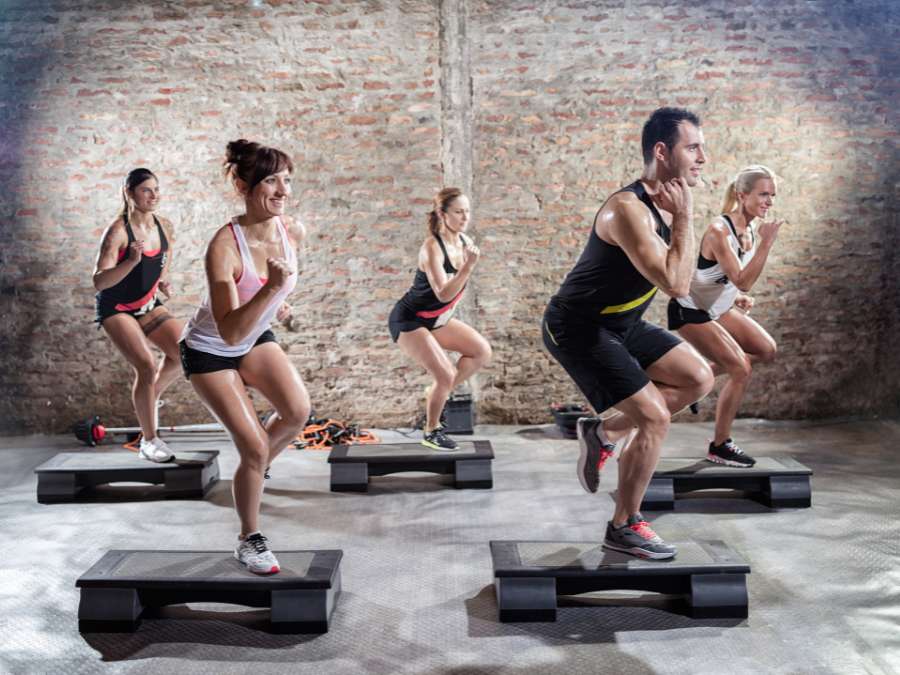
5. Buying Tips and Traps to Avoid
When buying gym flooring,I believe it’s important to consider more than just price and appearance. Choosing the right material can impact safety, durability, and maintenance in your facility. Here are some essential tips to help you make the best decision and avoid common traps:
- Choose the Right Material: Pick a flooring option that fits your budget and offers the best combination of properties for your gym. Use the comparison table above to help guide your decision.
- Prioritize Waterproof Options: When selecting rubber flooring, choose non-porous options to prevent moisture absorption. This makes cleaning easier, helps avoid mold or odors, and keeps your gym more hygienic.
- Use Underlays for Better Shock Absorption: For flooring with less shock absorption, especially in free weight or high-impact areas, install underlays to improve protection.
- Watch Out for Poor-Quality Materials: Low-quality flooring can sometimes release harmful chemicals, which can create health and safety problems. For example, some cheap vinyl floors may give off gases called VOCs (volatile organic compounds) that can lower air quality and cause breathing issues or allergies.
- Check Customer Reviews and Project Images: Read reviews to learn more about a material’s performance from specific brands. For example, look at photos of completed installations to see how the flooring will appear once installed.
Conclusion
In conclusion, the best gym flooring for your space will depend on what your gym needs and the types of workouts your members will do. By thinking about these factors and using the tips from this guide, you can pick the flooring that works best for your business.
We hope this gym flooring guide helps you make the right choice. If you are a gym owner looking for high-quality gym equipment, YR Fitness is here to help. Contact us today to learn about our products and how we can help meet your gym’s needs.
Dive Deeper Into Our Resources
Looking for more diverse product options? Browse through our handpicked selections:
For some insightful reads, we’ve curated a list of recommended articles just for you:
Still haven’t found what you’re looking for? Don’t hesitate to contact us. We’re available around the clock to assist you.
Related articles:





